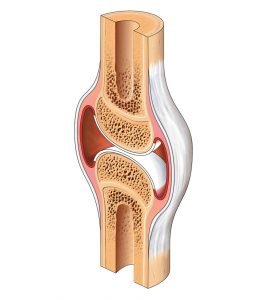The synovial fluid is located in a cavity that is between two bones of the joint and contained by the synovial membrane. This liquid is viscous and ensures that the joint can move smoothly. You could see it as a kind of lubricating oil.
How is synovial fluid produced and what is the composition of synovial fluid?

Furthermore, the synovial fluid also contains molecules (mainly glycosaminoglycans) which are made within the joint. These are, for example, hyaluronic acid and other proteoglycans such as the ‘superficial zone protein’ and lubricin. Hyaluronic acid and lubricin are made by the fibroblast-like synoviocytes (a cell type in the synovial membrane), and the ‘superficial zone protein’ is produced by the chondrocytes (cartilage cells) at the surface of the cartilage. Hyaluronic acid contributes to synovial fluid’s viscosity and ability to lubricate. Furthermore it prevents the flow of fluid to the bloodstream, due to its ability to retains water. Thus the joint fluid has a cushioning function for the forces that are put on the joint. Lubricine and the ‘superficial zone protein’ lubricate the cartilage surface. This lubrication allows different parts of the joint to be able to move smoothly over each other.
Finally, there are proteins present in the synovial fluid that regulate the structure and degradation of the cartilage matrix: ‘matrix metalloproteinases’ (MMPs), ‘a distintegrin and metalloproteinase with thrombospondin motifs’ (ADAMTS), and ’tissue inhibitors of metalloproteinases’ (TIMPs). These proteins are produced by chondrocytes and synoviocytes in response to stimuli they receive. More MMPs and ADAMTS are produced during a chronic inflammation. This affects the cartilage matrix, which is then gradually broken down.
What happens in case of an inflammation?
In rheumatoid arthritis, and to a lesser extent in osteoarthritis, there is considerable inflammation going on in the joint membrane. Due to inflammation, the regulating function of the mucous membrane is disrupted. As a result, larger blood proteins, and also blood cells, can end up in the synovial fluid. The increased amount of synovial fluid in the joints leads to swelling and impaired movement.
The cells in the mucous membrane, and in the cartilage, detect the inflammatory factors and leads to the production of other inflammatory factors. With this, the normal production of cartilage matrix and lubrication molecules is disrupted. When the inflammation is not interrupted, considerable damage will occur to the cartilage by increasing the amount of MMPs and ADAMTS. Ultimately, inflammatory factors also end up in the underlying bone, and pain increases. In more advanced osteoarthritis, the bone undergoes changes because it responds to the changed distribution of forces.
It is important to note that there are no nerve cells present in cartilage. Therefore, joint pain is not caused by cartilage damage alone. Pain is caused by the inflammation, or by damage to and increased forces on the bone or membrane. Both the membrane and bones have nerves. Osteoarthritis is therefore not a disease with only cartilage damage, because then one would not feel anything. Osteoarthritis, which is often still labeled as ‘worn out cartilage’, is accompanied by inflammation. The inflammation causes wear, and also plays a major role in the pain symptoms.
Read more about osteoarthritis and what you can do about it yourself.
Read more about rheumatoid arthritis and rheumatism.

Share this page
Tweet

Download for free the booklet ‘Moving without pain’ with a retail value of $6.75 / £4.95.
Any questions? Please feel free to contact us. Contact us.





